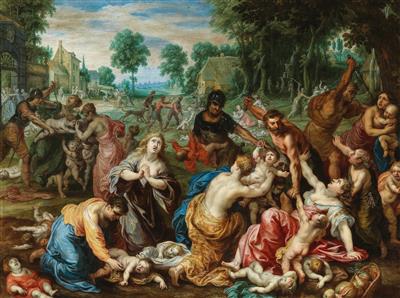Hendrik van Balen

(Antwerp 1575–1632) and
Jan Brueghel II
(Antwerp 1601-1678)
The Massacre of the Innocents,
signed and dated lower right: Balen 1624,
oil on panel, 53 x 70 cm, framed
Provenance:
G. Langhorne Burton, Somersby, Lincolnshire;
sale, Christie’s, London, 11 March 1895, lot 83 (as Rottenhammer)
The Massacre of the Innocents became a popular subject following the Turkish invasion of Southern Italy and the execution of the citizens (reportedly for refusing to convert to Islam) of Otranto in 1480-81. An influential engraving after Raphael by Raimondi was widely circulated.
Stylistically relevant to the present picture are the Massacre of the Innocents commissioned from Cornelis van Haarlem in 1590 by the Protestant Prince Mauritz (Rijksmuseum, Amsterdam, inv. no SK-A-128), and the circa 1612-13 treatment of the same subject by Rubens in the Thomson Collection, National Gallery of Ontario. While Rubens was himself the son of a Calvinist exile from Antwerp, art historians suggest the picture could be a Counter-Reformation propaganda piece. However gruesome the subject, the Massacre of the Innocents formed part of the visual vocabulary of the Renaissance and remained in use as a stylised reflection of the horrific realities of the Thirty Years War.
The massing of figures towards the foreground, with perspectival recession along the planes of their limbs towards a vanishing point abutted by architecture is common to both van Haarlem’s and Rubens’s compositions and also the present picture.
Hendrick van Balen, unlike van Haarlem, does not use the nude figure of a man bending over in the foreground, itself a quotation of a figure from Michelangelo’s lost Battle of Cascina fresco. Instead on the left in van Balen’s hand one can see a caring mother, a devout lady imploring the heavens for mercy and another wrestling to hold on to her baby, exposing her muscled back but otherwise all three of them respectably draped, typical of van Balen’s refinement.
Esperto: Damian Brenninkmeyer
 Damian Brenninkmeyer
Damian Brenninkmeyer
+43 1 515 60 403
old.masters@dorotheum.com
10.11.2020 - 16:00
- Prezzo realizzato: **
-
EUR 174.100,-
- Stima:
-
EUR 30.000,- a EUR 50.000,-
Hendrik van Balen
(Antwerp 1575–1632) and
Jan Brueghel II
(Antwerp 1601-1678)
The Massacre of the Innocents,
signed and dated lower right: Balen 1624,
oil on panel, 53 x 70 cm, framed
Provenance:
G. Langhorne Burton, Somersby, Lincolnshire;
sale, Christie’s, London, 11 March 1895, lot 83 (as Rottenhammer)
The Massacre of the Innocents became a popular subject following the Turkish invasion of Southern Italy and the execution of the citizens (reportedly for refusing to convert to Islam) of Otranto in 1480-81. An influential engraving after Raphael by Raimondi was widely circulated.
Stylistically relevant to the present picture are the Massacre of the Innocents commissioned from Cornelis van Haarlem in 1590 by the Protestant Prince Mauritz (Rijksmuseum, Amsterdam, inv. no SK-A-128), and the circa 1612-13 treatment of the same subject by Rubens in the Thomson Collection, National Gallery of Ontario. While Rubens was himself the son of a Calvinist exile from Antwerp, art historians suggest the picture could be a Counter-Reformation propaganda piece. However gruesome the subject, the Massacre of the Innocents formed part of the visual vocabulary of the Renaissance and remained in use as a stylised reflection of the horrific realities of the Thirty Years War.
The massing of figures towards the foreground, with perspectival recession along the planes of their limbs towards a vanishing point abutted by architecture is common to both van Haarlem’s and Rubens’s compositions and also the present picture.
Hendrick van Balen, unlike van Haarlem, does not use the nude figure of a man bending over in the foreground, itself a quotation of a figure from Michelangelo’s lost Battle of Cascina fresco. Instead on the left in van Balen’s hand one can see a caring mother, a devout lady imploring the heavens for mercy and another wrestling to hold on to her baby, exposing her muscled back but otherwise all three of them respectably draped, typical of van Balen’s refinement.
Esperto: Damian Brenninkmeyer
 Damian Brenninkmeyer
Damian Brenninkmeyer
+43 1 515 60 403
old.masters@dorotheum.com
|
Hotline dell'acquirente
lun-ven: 10.00 - 17.00
old.masters@dorotheum.at +43 1 515 60 403 |
| Asta: | Dipinti antichi |
| Tipo d'asta: | Asta in sala con Live Bidding |
| Data: | 10.11.2020 - 16:00 |
| Luogo dell'asta: | Wien | Palais Dorotheum |
| Esposizione: | 04.11. - 10.11.2020 |
** Prezzo d’acquisto comprensivo dei diritti d’asta acquirente e IVA
Non è più possibile effettuare un ordine di acquisto su Internet. L'asta è in preparazione o è già stata eseguita.
